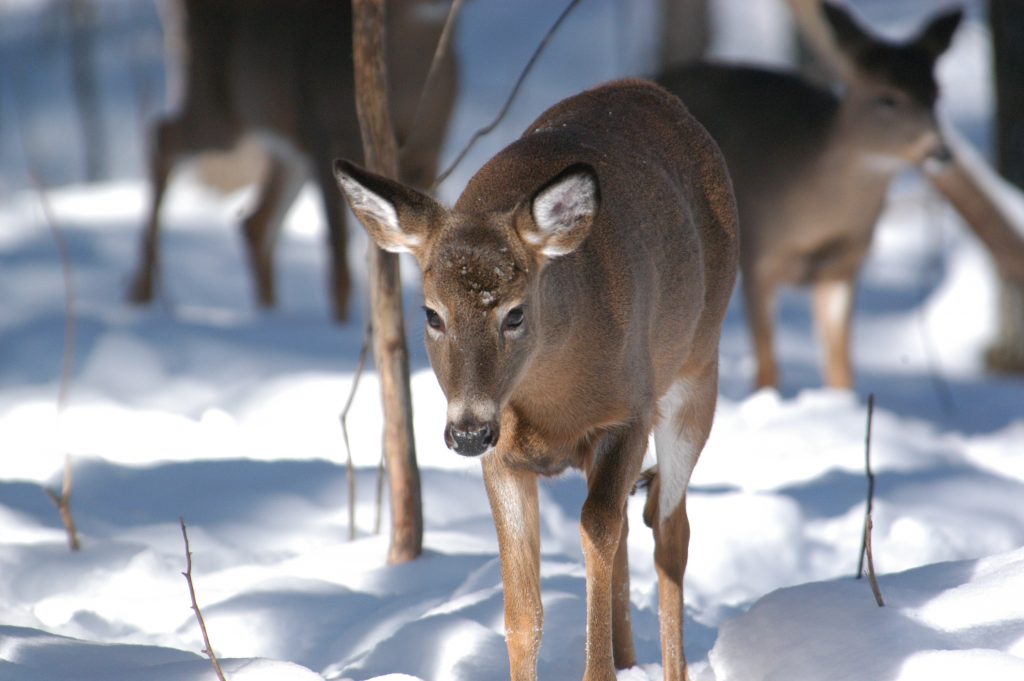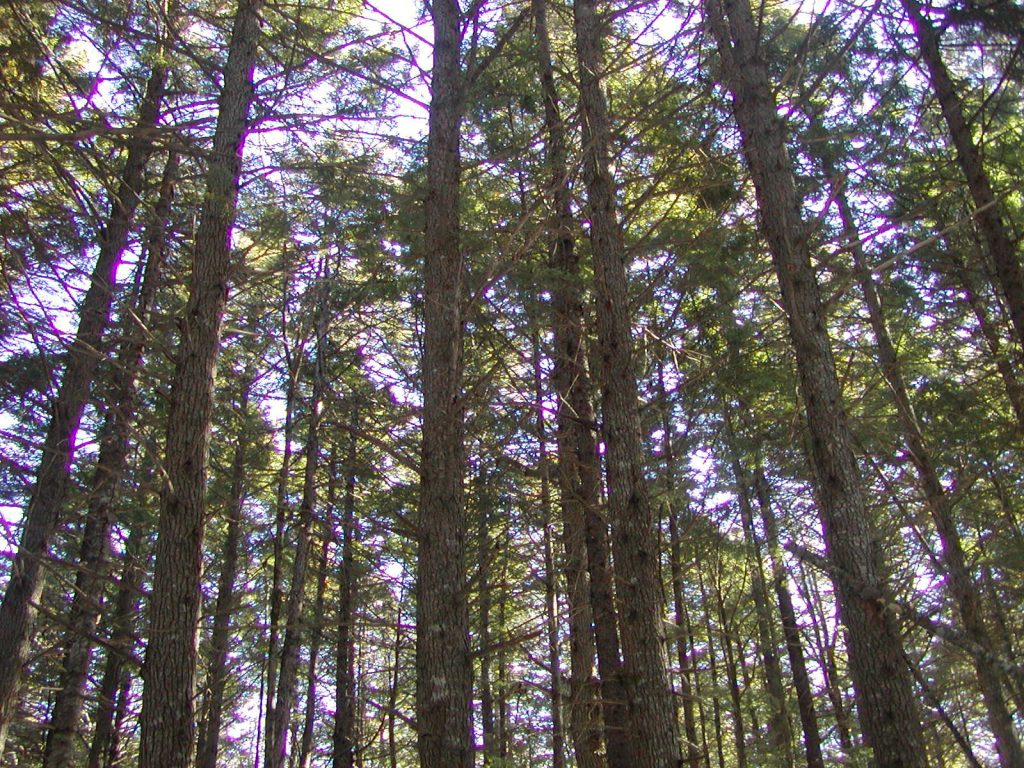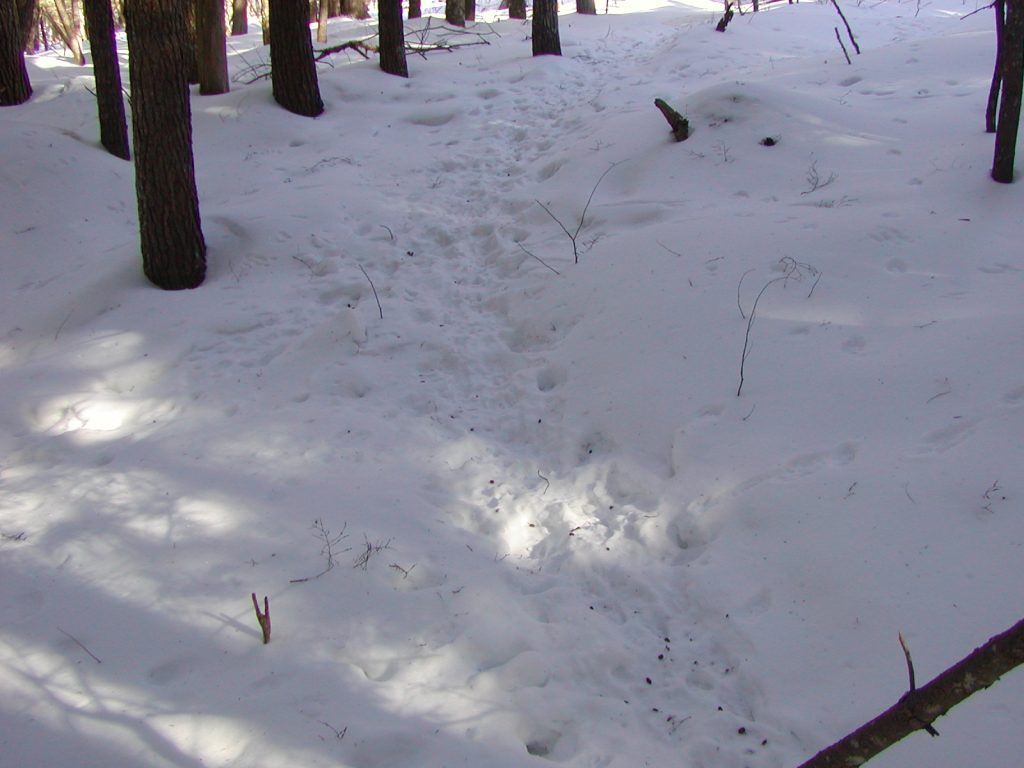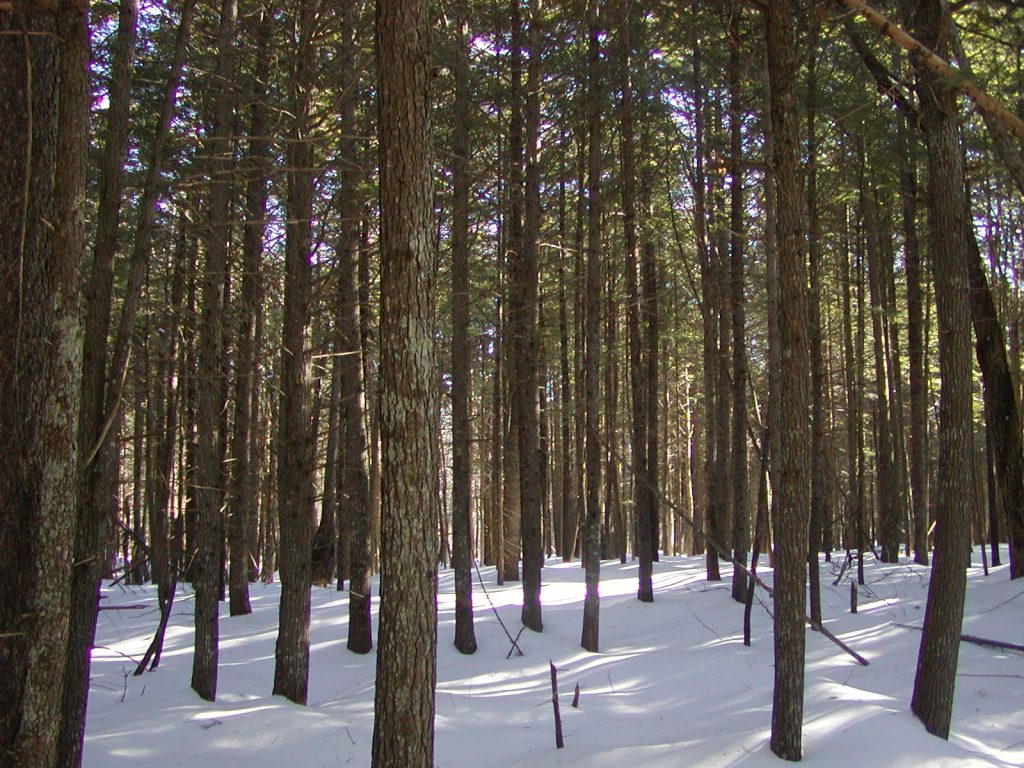ArrayFebruary 16, 2017 at 3:27 pm
 By Allen Starr, IFW Wildlife Biologist
Maine winters can be critical period for wildlife survival. Fortunately, Maine’s wildlife has developed adaptations and strategies to get them through long periods of cold temperatures and deep snow.
White-tailed deer have developed a strategy of seeking out mature, coniferous forests that contain trees at least 35 feet in height and provide dense canopy crown closures of 50 to 100%. These areas are composed primarily of cedar, hemlock, spruce, and/or fir and provide increased daily mean temperatures, wind reduction, and reduced snow depths. Snow depths under dense coniferous cover can be up to 40% less than open areas or hardwoods.
The location of these forest types across the landscape is also an important consideration when deer are choosing a place to survive the winter months, usually these habitats or deer yards are at low elevations near bodies of water (lakes, rivers, streams or wetlands). Deer congregate in these deer yards or Deer Wintering Areas (DWAs) to share the energetic cost of creating and maintaining trails while accessing food and winter shelter, and to avoid predation. DWAs are used year after year and use of these areas by deer is a learned behavior passed from doe to fawn.
[caption id="attachment_2160" align="alignleft" width="516"]
By Allen Starr, IFW Wildlife Biologist
Maine winters can be critical period for wildlife survival. Fortunately, Maine’s wildlife has developed adaptations and strategies to get them through long periods of cold temperatures and deep snow.
White-tailed deer have developed a strategy of seeking out mature, coniferous forests that contain trees at least 35 feet in height and provide dense canopy crown closures of 50 to 100%. These areas are composed primarily of cedar, hemlock, spruce, and/or fir and provide increased daily mean temperatures, wind reduction, and reduced snow depths. Snow depths under dense coniferous cover can be up to 40% less than open areas or hardwoods.
The location of these forest types across the landscape is also an important consideration when deer are choosing a place to survive the winter months, usually these habitats or deer yards are at low elevations near bodies of water (lakes, rivers, streams or wetlands). Deer congregate in these deer yards or Deer Wintering Areas (DWAs) to share the energetic cost of creating and maintaining trails while accessing food and winter shelter, and to avoid predation. DWAs are used year after year and use of these areas by deer is a learned behavior passed from doe to fawn.
[caption id="attachment_2160" align="alignleft" width="516"] The overhead forest canopy provides relief from deep winter snows.[/caption]
MDIFW has been identifying and mapping DWAs since the 1950s and realizes the importance of protecting these unique habitats to achieve public derived deer population goals. The Rockabema deer wintering area complex, owned and managed by Katahdin Forest Management, is a prime example of an area providing wintering habitat for generations of deer.
The Wildlife Division of the Maine Department of Inland Fisheries and Wildlife documented wintering deer along the Rockabema Stream area, south of Medway, as early as 1968. A deer wintering area aerial survey conducted by the Enfield Regional Wildlife biologists in the winter on 1971-1972 indicated a large concentration of deer along Rockabema Stream in TAR7 WELS and the southwestern corner of Medway. An additional area containing wintering deer was identified along Medunkeunk Stream in T2R9 NWP in 1972. Subsequent aerial surveys documented deer use in these areas in 1976 and 1978.
The Rockabema Stream yard was formally adopted as a P-FW (wildlife protection district) by the Land Use Regulation Commission 1979. A considerable amount of both aerial and ground surveys, conducted by wildlife biologists in the late 80’s and early 90’s, further indicated the initial areas of deer use had enlarged and merged into a large, deer wintering area complex. This high value area supported a conservative estimate of over 1000 deer each winter at that time.
[caption id="attachment_2158" align="alignright" width="401"]
The overhead forest canopy provides relief from deep winter snows.[/caption]
MDIFW has been identifying and mapping DWAs since the 1950s and realizes the importance of protecting these unique habitats to achieve public derived deer population goals. The Rockabema deer wintering area complex, owned and managed by Katahdin Forest Management, is a prime example of an area providing wintering habitat for generations of deer.
The Wildlife Division of the Maine Department of Inland Fisheries and Wildlife documented wintering deer along the Rockabema Stream area, south of Medway, as early as 1968. A deer wintering area aerial survey conducted by the Enfield Regional Wildlife biologists in the winter on 1971-1972 indicated a large concentration of deer along Rockabema Stream in TAR7 WELS and the southwestern corner of Medway. An additional area containing wintering deer was identified along Medunkeunk Stream in T2R9 NWP in 1972. Subsequent aerial surveys documented deer use in these areas in 1976 and 1978.
The Rockabema Stream yard was formally adopted as a P-FW (wildlife protection district) by the Land Use Regulation Commission 1979. A considerable amount of both aerial and ground surveys, conducted by wildlife biologists in the late 80’s and early 90’s, further indicated the initial areas of deer use had enlarged and merged into a large, deer wintering area complex. This high value area supported a conservative estimate of over 1000 deer each winter at that time.
[caption id="attachment_2158" align="alignright" width="401"] Well-travelled paths such as this one allow deer to travel without expending as much energy.[/caption]
As early as 1981, Katahdin Forest Management recognized areas in the southwestern portion of Medway in conjunction with the previously zoned area in TAR7 as providing quality winter shelter for deer. Discussions between IFW and KFM about developing a management plan first occurred in 1981.
During the 1980’s, both parties realized that the existing wintering area was much larger, and more important than had been originally thought. Additional travel corridors and concentrations of deer were identified and a collaborative plan was developed to maintain or improve deer wintering habitat over the long-term, while providing a sustained yield of forest products for the landowner. The wildlife goals of the plan are to manage the area to maintain and/or improve the carrying capacity for over-wintering deer and to maintain at least 50% of the area in quality winter shelter at all times. This was the basis for the cooperative, Rockabema Habitat Management Area Plan that is in place, today.
The Rockabema Plan encompasses 6,216 acres in the towns of Medway, TAR7 WELS and T2R9 NWP. It is comprised of six management units with connecting travel corridors. This is a signed, voluntary agreement between MDIFW and KFM that spans 15-year intervals. Enfield Regional Wildlife Biologists conduct site visits with KFM foresters to discuss timber harvest plans and to review post-harvest results.
This cooperative agreement is a prime example that with consideration given to winter shelter for deer and some effort put into planning, both quality deer wintering habitat can be achieved with a sustained yield of forest products. Katahdin Forest Management should be recognized and commended for their commitment to providing long-term, deer wintering habitat on the lands that they own and manage!
[caption id="attachment_2159" align="aligncenter" width="1024"]
Well-travelled paths such as this one allow deer to travel without expending as much energy.[/caption]
As early as 1981, Katahdin Forest Management recognized areas in the southwestern portion of Medway in conjunction with the previously zoned area in TAR7 as providing quality winter shelter for deer. Discussions between IFW and KFM about developing a management plan first occurred in 1981.
During the 1980’s, both parties realized that the existing wintering area was much larger, and more important than had been originally thought. Additional travel corridors and concentrations of deer were identified and a collaborative plan was developed to maintain or improve deer wintering habitat over the long-term, while providing a sustained yield of forest products for the landowner. The wildlife goals of the plan are to manage the area to maintain and/or improve the carrying capacity for over-wintering deer and to maintain at least 50% of the area in quality winter shelter at all times. This was the basis for the cooperative, Rockabema Habitat Management Area Plan that is in place, today.
The Rockabema Plan encompasses 6,216 acres in the towns of Medway, TAR7 WELS and T2R9 NWP. It is comprised of six management units with connecting travel corridors. This is a signed, voluntary agreement between MDIFW and KFM that spans 15-year intervals. Enfield Regional Wildlife Biologists conduct site visits with KFM foresters to discuss timber harvest plans and to review post-harvest results.
This cooperative agreement is a prime example that with consideration given to winter shelter for deer and some effort put into planning, both quality deer wintering habitat can be achieved with a sustained yield of forest products. Katahdin Forest Management should be recognized and commended for their commitment to providing long-term, deer wintering habitat on the lands that they own and manage!
[caption id="attachment_2159" align="aligncenter" width="1024"] Dense stands of softwood provide the best winter cover for white-tailed deer in Maine.[/caption]
Dense stands of softwood provide the best winter cover for white-tailed deer in Maine.[/caption]Categories